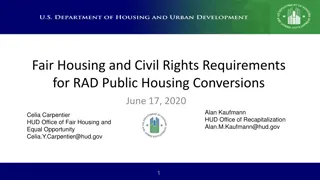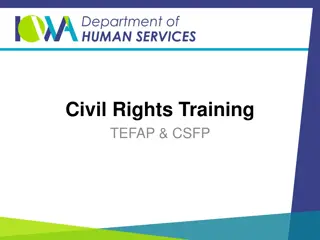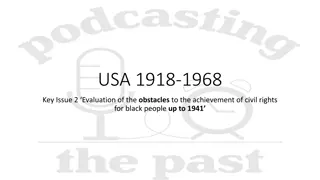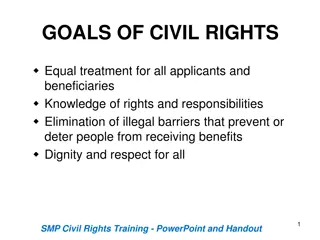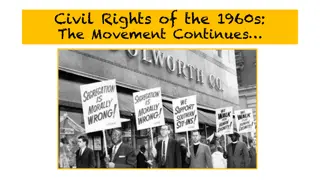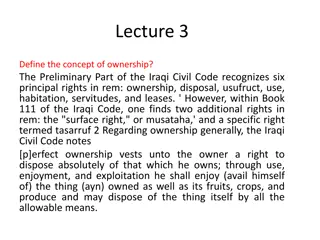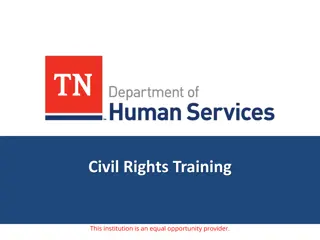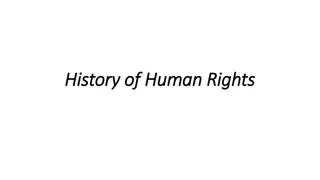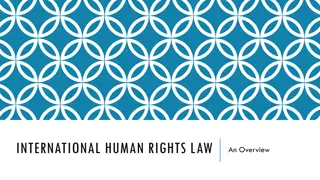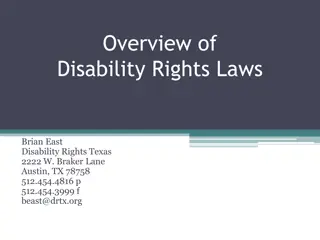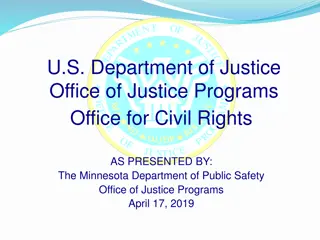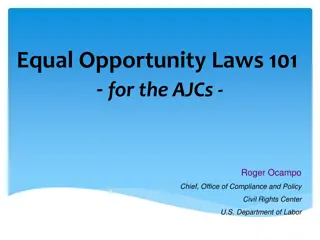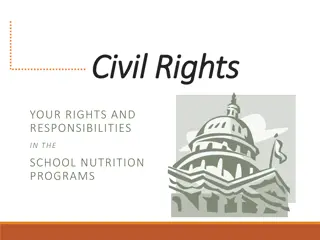Overview of Civil Rights Laws in the US
This content provides an overview of Civil Rights laws in the US, focusing on the Civil Rights Act of 1964 and Title VII, which created protected classes against discrimination based on race, color, religion, sex, and national origin. It also mentions other laws protecting classes such as age, disability, and veteran status, as well as what is considered legal in terms of hiring practices. The text emphasizes the importance of upholding these laws to ensure equal rights and opportunities for all individuals.
Download Presentation

Please find below an Image/Link to download the presentation.
The content on the website is provided AS IS for your information and personal use only. It may not be sold, licensed, or shared on other websites without obtaining consent from the author.If you encounter any issues during the download, it is possible that the publisher has removed the file from their server.
You are allowed to download the files provided on this website for personal or commercial use, subject to the condition that they are used lawfully. All files are the property of their respective owners.
The content on the website is provided AS IS for your information and personal use only. It may not be sold, licensed, or shared on other websites without obtaining consent from the author.
E N D
Presentation Transcript
Warhust et al,: Lookism: The New Frontier Great Expectations: Gender and Lookism at work March 18, 2019 For Wednesday: how this affects teachers and school children Note from the class web site for today: the Supreme Court gets a primer on Rap music lyrics, and how (not) to interpret them; recent article on difficulties of large people to get service in restaurants. Please read that for class on Wednesday and we will discuss. POLI 421, Framing Public Policies 1
Lets start with current US law Civil Rights Act of 1964 To enforce the constitutional right to vote, to confer jurisdiction upon the district courts of the United States to provide injunctive relief against discrimination in public accommodations, to authorize the attorney General to institute suits to protect constitutional rights in public facilities and public education, to extend the Commission on Civil Rights, to prevent discrimination in federally assisted programs, to establish a Commission on Equal Employment Opportunity, and for other purposes. POLI 421, Framing Public Policies 2
Title VII of this law created protected classes. You cannot discriminate against people based on: Race Color Religion Sex National origin POLI 421, Framing Public Policies 3
Other protected classes, from other laws: Age Discrimination in Employment Act (1967): Older people Americans with Disabilities Act (1990): people with disabilities Uniformed Services Employment Rights Act of 1994: veterans Title IX from the Education Amendments of 1972 (as amended) outlawed discrimination based on: Age, color, disability, gender, gender expression, gender identity, genetic information, national origin, race, religion, sex, sexual orientation, or veteran status. (Note: this only applies to educational institutions ) POLI 421, Framing Public Policies 4
Some things that clearly ARE legal: Hire qualified people, use tests and interviews Airplane pilots have to know how to fly Chefs have to know how to cook Includes physical tests such as to be a marine or a police officer Hire people you like No requirement to hire jerks or obnoxious people Hire your kids (no in public agencies, but certainly in private businesses) Hire people who live near you, or who know your kids, or who share a school connection with you, or whatever you want to do Lots of freedoms here POLI 421, Framing Public Policies 5
Some other things that are legal Hire attractive people Hire people who are not obese Hire people who do not smoke Hire people who do not have tattoos, nose rings, piercings Hire people who look middle class / preppy / wasp (as long as it s not only whites, etc. violating the protected class rules) A number of studies have linked perceived physically attractiveness to higher pay and better job prospects. In the UK, Harper (2000) surveyed 11,000 33-year-old employees and discovered that unattractive men were paid 15% less and unattractive women 11% less, creating a penalty for plainness . Hamermesh and Biddle (1994), drawing on household survey data for over 10,000 Americans and Canadians, found similar results (Warhurst et al. 2012, 77). POLI 421, Framing Public Policies 6
OK, so lets think of some groups who are not protected from employment, housing, and other forms of discrimination: Obviously the list from Title IX which applies to universities, is broader than the general law for employment and other areas: gender expression, gender identity, genetic information sexual orientation LGBTQ (protected in some states, not others; no federal protection) What other unprotected groups can you think of? POLI 421, Framing Public Policies 7
Warhurst et al. Lookism and Employment Discrimination The style labor market : boutique hotels, style bars, etc., This pilot study revealed that these companies desired and developed employees who could become the physical embodiment of the corporate image and personality . These employers believed that having employees who look the part helped create a distinctive company image and provided competitive advantage for these companies in the crowded retail and hospitality industries (p. 133) But this expanded to virtually all employers: Asked to assess the centrality of employee appearance to business success, 93 percent of employers stated it to be either critical or important, with 90 percent citing the right appearance as a critical recruitment criterion (p. 133) POLI 421, Framing Public Policies 8
Use the current law, or make a new class? Unattractive people not protected, but maybe we can use race, gender, or disability protections in the current law to protect people? Note: p. 133, 2.7 percent of employers said they request photos, but 23 percent of employees said they had to provide a photo. (This is illegal under UK law ) The state of Victoria, Australia went another direction: they explicitly protected people on the basis of appearance. POLI 421, Framing Public Policies 9
Lookism in the workplace (Great expectations The state of Victoria (Australia) creates a protected class based on physical appearance So the authors reviewed complaints to the Equal Opportunity Commission of that state Emotional labor : service work, interacting with customers, smiling, being nice etc Aesthetic labor : looking nice, at least as defined by the employer. Employees are, for example, hired because of the way they look and talk; once employed, they are instructed how to stand whilst working, what to wear and how to wear it and even what to say to customers because such comportment, dress and speech appeal to the visual and aural senses of customers and thereby enhance the service encounter (p.71) POLI 421, Framing Public Policies 10
Lets make a list where companies want attractive employees to deal with customers: Airlines, traditionally Restaurants and bars Clothing stories Where else can you think of? POLI 421, Framing Public Policies 11
Question: Can an unattractive person sell clothes? Discrimination on the basis of being able to do the job has always been allowed. So, would you buy clothes in a store where the sales attendant was not attractive? POLI 421, Framing Public Policies 12
1995 amendments to the Victoria (Australian) EEO law: physical features The Act defines physical features as height, weight, size or other bodily characteristics including attributes such as hair length or colour But, it specifies: an employer can create and maintain an image for their organisation that best suits their industry and their clients needs by setting reasonable standards of dress, appearance and behaviour. (EOC, n.d) POLI 421, Framing Public Policies 13
Results of their review Hundreds of cases every year; About 2/3 from women, lower than they expected. Discuss: Do you think that the authors seem to imply, between the lines, that if it is happening to men, then maybe it s a serious problem? POLI 421, Framing Public Policies 14
More of their summary Research on aesthetic labour in the UK by Walls (2008) reveals that the importance of employee styling also applies to men in interactive service. The men in his study of fashion retailers would use their aesthetic attributes in seeking employment and male workers had to offer cool , style and trendiness (p.110) once in work (p. 85) In her research of the hospitality industry Boyle (2007) also notes how employers direct well-groomed male workers to serve female customers and direct female workers to attend to male customers. It was part of the job for both groups of workers and intended by employers to boost custom. (p. 85) POLI 421, Framing Public Policies 15
If you owned a bar Would you send a male waiter to wait on a table of women? Would you send a female waitress to wait on a table of men? What if this was a proven way to boost custom and the employees would get better tips? POLI 421, Framing Public Policies 16
If you owned an accounting firm Would you want your employees in the back rooms looking good ? Would you want your receptionists and others who deal with customers looking good ? How about a law firm, District Attorney, or another who might have a lawyer appear in court? Can the lawyer wear a nose ring? Be tatted up? How would the jury respond to that? POLI 421, Framing Public Policies 17
Lets frame this issue as Team 1. A new civil right based on appearance Team 2. Unbearable government regulation that goes against common sense, the free market, and the rights of business owners to run their business in a way that will be successful, attract customers, and build jobs, profits, and tax revenues. Each team, take five minutes and report out your talking points, arguments, and frames POLI 421, Framing Public Policies 18







